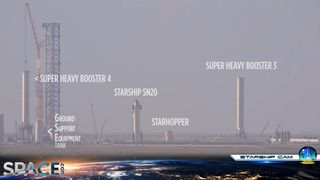SpaceX's Starship SN20 rolls out to launch pad ahead of 1st orbital test flight
SpaceX rolled out its next version of Starship to the pad Thursday (Aug. 5) as the company shoots for an ambitious orbital test.
The Starship prototype, known as SN20, left its production facility near the South Texas village of Boca Chica to arrive at the launch pad — joining the Super Heavy first-stage booster that arrived there two days before.
While SpaceX and founder Elon Musk have yet to comment on the rollout on Twitter, the event was carried live as the company prepares for this new mission — which SpaceX hopes to fly within the next few months, depending on technical and regulatory progress for the mission.
Video: Watch SpaceX's Starship SN20 & a fuel tank roll out to launch site
Photos: SpaceX lifts huge Super Heavy rocket onto launch stand

The 230-foot-tall (70 meters) Booster 4 will soon go through a series of pressurization and engine tests. Providing Booster 4 passes the trials, the rocket will then be prepared to send SN20 on a round-the-world trip. But it's unclear when the rocket will launch, given that the U.S. Federal Aviation Administration is performing an environmental review of Starship's launch operations, and we don't know when that will finish.
The orbital flight plan calls for Booster 4 to splash down in the Gulf of Mexico, about 20 miles (32 kilometers) offshore, a few minutes after launch. SN20 will continue into orbit, make one circuit of Earth and then come down in the Pacific Ocean roughly 90 minutes after liftoff, near the Hawaiian island of Kauai.
NASA recently selected Starship as the crewed lander for its Artemis program, which plans to put humans on the moon later in the 2020s. Starship is a fully reusable, two-stage transportation system that SpaceX plans to use to ferry cargo and people to the moon, Mars and other destinations in the solar system.
Get the Space.com Newsletter
Breaking space news, the latest updates on rocket launches, skywatching events and more!
SN20 (which is short for "Serial No. 20") is the latest in a series of prototype launches for the Starship series. For example, a three-engine vehicle known as SN15 flew to a maximum altitude of 6.2 miles (10 km) in May and came down for a safe landing back on Earth.
The final version of the Starship spacecraft will have six Raptor engines, and the final Super Heavy version will likely be powered by 32 Raptor engines, Musk has said. The upper stage is 165 feet (50 meters) tall and is also known, confusingly, as Starship.
Follow Elizabeth Howell on Twitter @howellspace. Follow us on Twitter @Spacedotcom and on Facebook.
Join our Space Forums to keep talking space on the latest missions, night sky and more! And if you have a news tip, correction or comment, let us know at: community@space.com.

Elizabeth Howell (she/her), Ph.D., is a staff writer in the spaceflight channel since 2022 covering diversity, education and gaming as well. She was contributing writer for Space.com for 10 years before joining full-time. Elizabeth's reporting includes multiple exclusives with the White House and Office of the Vice-President of the United States, an exclusive conversation with aspiring space tourist (and NSYNC bassist) Lance Bass, speaking several times with the International Space Station, witnessing five human spaceflight launches on two continents, flying parabolic, working inside a spacesuit, and participating in a simulated Mars mission. Her latest book, "Why Am I Taller?", is co-written with astronaut Dave Williams. Elizabeth holds a Ph.D. and M.Sc. in Space Studies from the University of North Dakota, a Bachelor of Journalism from Canada's Carleton University and a Bachelor of History from Canada's Athabasca University. Elizabeth is also a post-secondary instructor in communications and science at several institutions since 2015; her experience includes developing and teaching an astronomy course at Canada's Algonquin College (with Indigenous content as well) to more than 1,000 students since 2020. Elizabeth first got interested in space after watching the movie Apollo 13 in 1996, and still wants to be an astronaut someday. Mastodon: https://qoto.org/@howellspace
